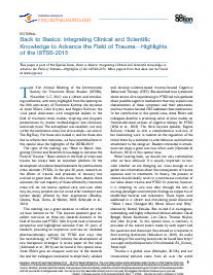Back to Basics : Integrating Clinical and Scientific Knowledge to Advance the Field of Trauma-Highlights of the ISTSS-2015.
The 31st Annual Meeting of the International Society for Traumatic Stress Studies (ISTSS), November 5–7, 2015, was a vibrant and stimulating conference, with many highlights from the opening on the 10th anniversary of Hurricane Katrina; the keynotes, the vivid panel discussions with recognized leaders in the field of traumatic stress studies; inspiring and eloquent presentations by master methodologists and clinicians; and much more. The atmosphere was excellent, not only within the conference venue, but also outside—we were in The Big Easy. For those who missed it, and for those who like to refresh their memories, we have assembled here in this special issue the highlights of the ISTSS-2015!
Reference:
Bernet Elzinga, Christian Schmahl, and Miranda Olff | 2016
In: European journal of psychotraumatology, ISSN 2000-8066 | 7 | november | 33765
http://doi.org/10.3402/ejpt.v7.33765
In: European journal of psychotraumatology, ISSN 2000-8066 | 7 | november | 33765
http://doi.org/10.3402/ejpt.v7.33765
Keywords:
Posttraumatic Stress Disorder, Psychotrauma, PTSD (en), Research, Scientific Research
Affiliation author(s):


